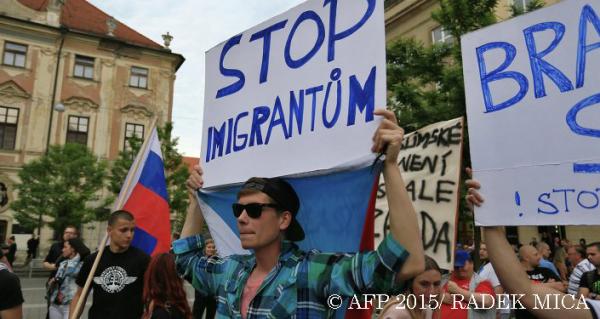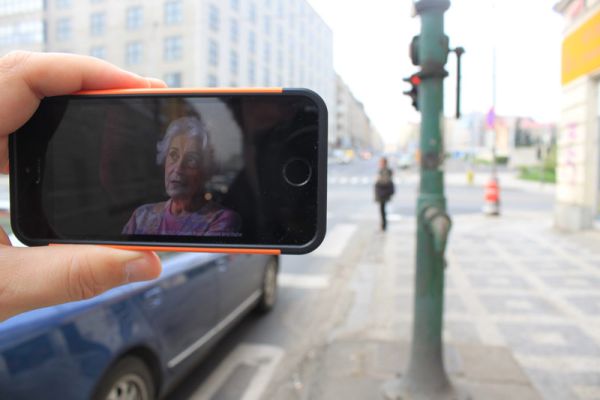Look at them! - The plight of refugees in the Republic
The President of the Republic went on record to tell the prospective immigrants “nobody invited you here!” Refugees escaping from a murderous regime are regarded as agents of that very regime. Concerned citizens who never saw a refugee discuss them with great fear: refugees will take our jobs, kill our wives, rape our daughters. “We may take a few of those who can prove they are and always were Christians,” some interior ministry clerk declared.
No, this is not about the scare caused in Prague by the wave of refugees from Nazi Germany in 1938, even though the language and fear is the same. This is Prague in the summer of 2015. Half a year of intense media message was enough to transform the otherwise tolerant majority of Czech society into a mirror image of the shameful Second Republic, substituting the dreadful Jewish and German refugees with the dreadful Syrian refugees and Muslims in general.
“Look at them, our typical Prague sailors,” says the otherwise knowledgeable tour guide while pointing out the black men from Africa selling boat tickets to the hordes of tourists crossing the Charles bridge, “soon we will have to wear scarves on our heads.” The discussion about refugees and migrants features prominently in everyday interactions, from the tram stop chatter to the blogosphere: “I never was a racist, but observing what is going on, I realized all this black stuff belongs to the ovens! We have so little ourselves and we shall feed and support these? They have such good cellphones and can pay to travel so far away, and I cannot even afford a holiday at sea!” - “There are billions to give to this vermin, they get everything for free, and our children are dying because we cannot afford medical help for them!” - “One also has to drown kittens when there are too many of them. Let the nature perform its tasks.” A billboard sign on the Czech border with Austria has even blunter message. Featuring gallows with a hanged man it states: “Immigrants do not enter. Auschwitz 300 kilometers.”

The numbers of refugees involved in the Czech story are miniscule, in the hundreds. All they want is to continue their travels to reach relatives in Western Europe. Czech police stops refugees and interns them in camps with no chance to work, support their families or communicate with relatives. But the local media and especially social networks are awash with fake stories of Muslim invasion: thousands flooding our cities, sharia declared here, Czech Christians persecuted in their own land. The paranoia, hysteria and fear of the unknown are snowballing out of all proportions.
Last week, an Appeal of Czech Scientists was published, a first organized voice going against the tide. Signed by many prominent Czech individuals, it states that "many politicians and media use rhetoric promoting fear of foreigners and indifference to their suffering, attitude formerly regarded as extreme and unacceptable. The immigrants, human beings, are described as pests or parasites pouring into our country in order to abuse the social system or murder and rape. (...) A day does not pass without our nation of supposedly dovish voices wishing death to this or that group of foreigners. None of this reflects the reality. The behavior does not have much to do with the migration crisis, it rather reflects a disease of our own society that lost its humanity and sanity."
How should an educator react? I do believe the first action should be of removing all the labels. We are talking about people here, human beings. Each one of them is unique. We should not be applying our fears or even past experiences to a whole mass of people who may have very little in common. Every refugee is an individual and should be viewed – and judged – as an individual. There is no reason to hate - or love - ALL OF THEM.
A responsible educator is aware of mechanisms of hate propaganda, and teaches its basics: the construct of an enemy, divisionism and dehumanization. Content in USC Shoah Foundation’s Visual History Archive could be tremendously helpful in such efforts, as there is a whole plethora of escapee, refugee, migrant and immigrant experiences captured within.
Activities from the Institute’s free education website, IWitness is another powerful teaching tool. In this case, the primary focus should not be on the Jews or the Jewish experience during the Holocaust, but rather on analyzing the reactions of the various indigenous populations to transients or newcomers, and the motivations for these reactions. More often then not, the fear of the unknown and the anti-refugee rhetoric were used for political purposes that had nothing to do with the refugees. The more self-confident the society, the less susceptible it is to accepting such simple enemy constructs.

A fascinating locally relevant example perfectly fit for educational activities is the transit of as many as 200,000 Jewish refugees, mostly from Poland, across the Czechoslovak territory in 1945–1948, movement known as the Bricha. Despite protests from Great Britain, the United States, Poland and the Soviet Union, Czechoslovakia enabled these refugees to move to DP camps in the western occupation zones of Germany and Austria. This Czechoslovak aid was based on a government resolution that required a firm guarantee that none of these refugees would remain on Czechoslovak territory. The preserved official correspondence about these post-WWII refugees contains statements that could have been written today: they were described as dangerous militants, maybe even armed terrorists planning attacks, undesirable elements who can never play according to any rules, black marketers and wheeler-dealers not worthy of any help, assistance or attention.
Thanks to the Visual History Archive, we can listen to authentic individual voices of those refugees. Listening to a refugee narrative filled with illegal border crossings and stories of random acts of kindness may help us relate better to the refugee crisis of today.